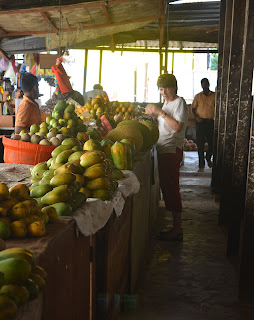Much of our journey was inspired by the SBS Series - "My Sri Lanka with Peter Kuruvita" (available on DVD from SBS Australia)
Every city, town
and village in Sri Lanka has it's Central Markets, but Jaffna Markets
features high in the spices and fragrances of this tropical island.
every spice you can imaging used in cooking
all forms of dried fish for curries
piles of fresh grown vegatables
4 different types of bananas
don't forget the coconuts
sweets, toffees, chilli peanuts, lollies, mixed nibblies.....
plenty of trinkets, cooking pots, jewellery to keep even Sharon interested
Finally the Grand Finale - LUNCH
Curried Mutton (Goat) & Vegetables, wrapped in Roti, covered in breadcrumbs & deep fried with Milk Tea
So ends a long day with an all time favourite.....























































